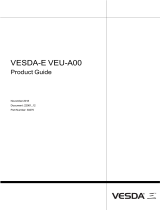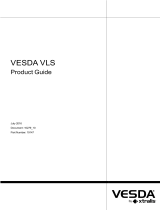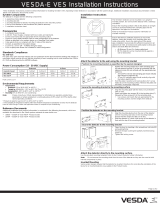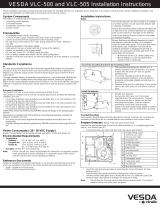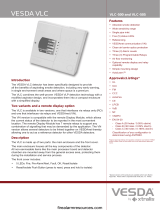Page is loading ...

VESDA-E VEU-A10
Product Guide
November 2018
Document: 22077_12
Part Number: 30334


VESDA-EVEU-A10 Product Guide
www.xtralis.com i
Intellectual Property and Copyright
This document includes registered and unregistered trademarks. All trademarks displayed are the trademarks of
their respective owners. Your use of this document does not constitute or create a licence or any other right to use
the name and/or trademark and/or label.
This document is subject to copyright owned by . You agree not to copy, communicate to the public, adapt,
distribute, transfer, sell, modify or publish any contents of this document without the express prior written consent of
Xtralis.
Disclaimer
The contents of this document is provided on an “as is” basis. No representation or warranty (either express or
implied) is made as to the completeness, accuracy or reliability of the contents of this document. The manufacturer
reserves the right to change designs or specifications without obligation and without further notice. Except as
otherwise provided, all warranties, express or implied, including without limitation any implied warranties of
merchantability and fitness for a particular purpose are expressly excluded.
General Warning
This product must only be installed, configured and used strictly in accordance with the General Terms and
Conditions, User Manual and product documents available from Xtralis. All proper health and safety precautions
must be taken during the installation, commissioning and maintenance of the product. The system should not be
connected to a power source until all the components have been installed. Proper safety precautions must be taken
during tests and maintenance of the products when these are still connected to the power source. Failure to do so
or tampering with the electronics inside the products can result in an electric shock causing injury or death and may
cause equipment damage. Xtralis is not responsible and cannot be held accountable for any liability that may arise
due to improper use of the equipment and/or failure to take proper precautions. Only persons trained through an
Xtralis accredited training course can install, test and maintain the system.
Liability
You agree to install, configure and use the products strictly in accordance with the User Manual and product
documents available from Xtralis.
Xtralis is not liable to you or any other person for incidental, indirect, or consequential loss, expense or damages of
any kind including without limitation, loss of business, loss of profits or loss of data arising out of your use of the
products. Without limiting this general disclaimer the following specific warnings and disclaimers also apply:
Fitness for Purpose
You agree that you have been provided with a reasonable opportunity to appraise the products and have made
your own independent assessment of the fitness or suitability of the products for your purpose. You acknowledge
that you have not relied on any oral or written information, representation or advice given by or on behalf of Xtralis
or its representatives.
Total Liability
To the fullest extent permitted by law that any limitation or exclusion cannot apply, the total liability of Xtralis in
relation to the products is limited to:
i. in the case of services, the cost of having the services supplied again; or
ii. in the case of goods, the lowest cost of replacing the goods, acquiring equivalent goods or having the goods
repaired.
Indemnification
You agree to fully indemnify and hold Xtralis harmless for any claim, cost, demand or damage (including legal costs
on a full indemnity basis) incurred or which may be incurred arising from your use of the products.
Miscellaneous
If any provision outlined above is found to be invalid or unenforceable by a court of law, such invalidity or
unenforceability will not affect the remainder which will continue in full force and effect. All rights not expressly
granted are reserved.

VESDA-EVEU-A10 Product Guide
ii www.xtralis.com
Scope
The VESDA-E VEU-A10 Product Guide provides a comprehensive description of the VESDA-E VEU-A10
detector and its accessories.
This guide introduces the VEU-A10 features, technical specifications and gives an understanding of its
components and their function. You will also find instructions on installing, cabling and powering up the
detector.
This guide is for anyone involved with the design, maintenance and purchasing of a VESDA-E system. It is
assumed that anyone using this product has the knowledge and appropriate certification from local fire and
electrical authorities.
Document Conventions
The following typographic conventions are used in this document:
Convention Description
Bold Used to denote: emphasis.
Used for names of menus, menu options, toolbar buttons
Italics Used to denote: references to other parts of this document or other
documents. Used for the result of an action.
The following icons are used in this document:
Convention Description
Caution: This icon is used to indicate that there is a danger to
equipment. The danger could be loss of data, physical damage, or
permanent corruption of configuration details.
Warning: This icon is used to indicate that there is a danger of electric
shock. This may lead to death or permanent injury.
Warning: This icon is used to indicate that there is a danger of inhaling
dangerous substances. This may lead to death or permanent injury.
Contact Us
UKand Europe +44 1442 242 330
The Americas +1 800 229 4434
Middle East +962 6 588 5622
Asia +86 21 5240 0077
Australia and New Zealand +61 3 9936 7000
www.xtralis.com

VESDA-EVEU-A10 Product Guide
www.xtralis.com iii
Codes and Standards Information for Air Sampling Smoke Detection
We strongly recommend that this document is read in conjunction with the appropriate local codes and standards
for smoke detection and electrical connections. This document contains generic product information and some
sections may not comply with all local codes and standards. In these cases, the local codes and standards must
take precedence. The information below was correct at time of printing but may now be out of date, check with your
local codes, standards and listings for the current restrictions.
FCC Compliance Statement
This equipment has been tested and found to comply with the limits for a Class B digital device, pursuant to part 15
of the FCC Rules. These limits are designed to provide reasonable protection against harmful interference in a
residential installation. This equipment generates, uses and can radiate radio frequency energy and, if not installed
and used in accordance with the instruction, may cause harmful interference to radio communications. However,
there is no guarantee that interference will not occur in a particular installation. If this equipment does cause
harmful interference to radio or television reception, the user is encouraged to try to correct the interference by one
or more of the following measures; re-orientate or relocate the receiving antenna, increase the separation between
the equipment and receiver, connect the equipment to a power outlet which is on a different power circuit to the
receiver or consult the dealer or an experienced radio/television technician for help.
FDA
This Xtralis product incorporates a laser device and is classified as a Class 1 laser product that complies with FDA
regulations 21 CFR 1040.10. The laser is housed in a sealed detector chamber and contains no serviceable parts.
The laser emits light which can be hazardous to the eye. Under no circumstances should the detector chamber be
opened.
The laser chamber is identified by the labels shown below:
DANGER
DO NOT OPEN
NO SERVICEABLE
PARTS
Laser Radiation when Open
AVOID DIRECT EXPOSURE TO BEAM
NE PAS OUVRIR
DISPOSITIFS/PIECES
NON ECHANGEABLES
Rayonnement Laser en cas d’ouverture
EVITEZ TOUTE EXPOSITION DIRECTE AU FAISCEAU
CLASS 1
LASER PRODUCT
PRODUIT LASER
DE CLASSE 1
AS1603.8
The performance of this product is dependent upon the configuration of the pipe network. Any extensions or
modifications to the pipe network may cause the product to stop working correctly. All pipe network designs must be
validated using ASPIRE. ASPIRE is available from your authorized representative.
The product is not intended to be mounted in hostile environments but is able to sample from hostile environments.
AS1851.1 2005
Maintenance Standards. Wherever this document and the AS1851.1 differ, AS1851.1 should be followed in
preference to this document.

VESDA-EVEU-A10 Product Guide
iv www.xtralis.com
Regional Regulatory Requirements and Notices
UL and ULC
For open area, open area high velocity and duct protection the fire alarm threshold (setting) that initiates an
evacuation signal must be set such that the sensitivity of each sampling hole is more sensitive than 10%/m
(3.2 %/ft) as determined by the ASPIRE software.
European Installations
EN 54-20
The product must use a power source conforming to EN 54-4 and EN60950-1 Section 2.5.
The product is compliant with EN 54-20 sensitivity requirements provided the following conditions are met:
l For a Class A detector, hole sensitivity must be better than 1.5% obscuration/m and transport time less
than 70 seconds
l For a Class B detector, hole sensitivity must be better than 3% obscuration/m and transport time less
than 90 seconds
l For a Class C detector, hole sensitivity must be better than 10% obscuration/m and transport time less
than 110 seconds
These limits should be verified using ASPIRE during the design of the sampling pipe network.
The product is compliant with EN 54-20 flow monitoring requirements provided the following conditions are
met:
l The minor low and minor high flow thresholds should be set at 85% and 115% respectively
l The flow through the detector predicted by ASPIRE must be greater than 20 L/m.
Additional information:
The VESDA-E VEU-A10 passed the EN 54-20 fire tests with the following configurations:
l Class A with 80 holes and a Fire-1 setting of 0.015% obs/m
l Class B with 80 holes and a Fire-1 setting of 0.026% obs/m
l Class C with 100 holes and a Fire-1 setting of 0.062% obs/m
Japanese Installations
To comply with Japanese local code requirements the WiFi capability shall be disabled.
Product Listings
l UL
l ULC
l FM
l ActivFire
l CE
l VdS
l EN 54-20
l ISO 7240-20
l NF
Regional approvals listings and regulatory compliance vary between product models. Refer to www.xtralis.com for
the latest product approvals matrix.
Document: 22077_12
Part Number: 30334

VESDA-EVEU-A10 Product Guide
www.xtralis.com 1
Table of Contents
1 Introduction 3
1.1 Features 3
2 Product Information 5
2.1 Detector Components 5
2.2 How the VEU-A10 works 5
2.3 Front Panel 6
2.4 Internal Buttons 8
2.5 Communication Ports 8
2.6 VESDAnet 9
2.7 Specifications 11
2.8 Dimensions 13
3 Pipe Network Design and Installation 17
3.1 Design Considerations 17
3.2 Installation Considerations 17
3.3 Pipe Inlets 17
3.4 Managing the Exhaust Air 18
4 Installation 19
4.1 Prepare the Detector 19
4.2 Mounting 20
4.3 Wiring 35
4.4 Powering Up 45
4.5 Installation Checklist 46
4.6 Preliminary System Check 47
5 Configuration 49
5.1 Communication between Xtralis VSC and the detector 49
5.2 Connecting to the Detector 53
5.3 Security 56
5.4 Commands 58
5.5 Configuration Options 61
5.6 Factory Default Settings 73
6 Commissioning 77
6.1 AutoLearn Smoke 77
6.2 AutoLearn Flow 78
6.3 Commissioning Smoke Test 78
7 Maintenance 79
7.1 Standby 79
7.2 Open the Door 80
7.3 Replacing the Filter 81
7.4 Remove the Fascia 84
7.5 Replacing the Aspirator 86
7.6 Replacing the Smoke Detection Chamber 88
7.7 Replacing the Sampling Module 92
7.8 Spare Parts 96
8 Troubleshooting 97
8.1 Fault Reporting through Relays 97
8.2 Troubleshooting with the Front Panel Display 97
8.3 Troubleshooting with Xtralis VSC 99
A Commissioning Forms 101
A.1 VEU-A10 Detector Commissioning Configuration 103
A.2 ASPIRE Data 103

VESDA-EVEU-A10 Product Guide
www.xtralis.com 3
1 Introduction
The VESDA-E VEU-A10 is an aspirating smoke detector (ASD) that provides very early warning of fire
conditions by drawing air samples through an air sampling pipe network.
Figure1-1: VESDA-E VEU-A10 Aspirating Smoke Detector
The detector easily interfaces with fire warning and fire suppression release systems, and can be integrated
into a building management system (BMS).
1.1 Features
The VEU-A10 detector contains the following features:
l Short wavelength laser-based detection
l Inherent absolute calibration
l Clean air barrier for optics protection
l More robust contamination resistance
l Ultra-wide sensitivity range
l Flow fault thresholds configurable per port
l Long-life, easy-to-replace air sample filter
l 3.5" colour touch screen for status review
l Quiet operation
l Advanced remote diagnostics
l Area coverage up to 6,500 m² (69,965 ft²)
l Up to four inlet pipes
l Total maximum pipe length of 800 m (2625 ft)
l Referencing
l AutoLearn™ Smoke and Flow
l Seven programmable relays
l Two General Purpose Inputs (GPIs), one monitored and one unmonitored
l Ultrasonic flow sensing
l Xtralis VSC, Xtralis VSM4 and ASPIRE PC software support
l IP 40 enclosure (not UL tested)
l Easy mounting with steel support bracket
l Field replaceable aspirator, sampling module, filter and detection chamber
l VESDAnet networking
l Ethernet 100 base T
l WiFi, 802.11 b/g/n
l Local host mode USB port
l Easy cable termination access
l Event Log (20,000 events)

VESDA-EVEU-A10 Product Guide
4 www.xtralis.com
This page is intentionally left blank.

VESDA-EVEU-A10 Product Guide
www.xtralis.com 5
2 Product Information
2.1 Detector Components
The VEU-A10 detector contains field-replaceable Filter, Aspirator and Chamber Assembly components.
These are shown below in Figure2-1.
F
D
C
B
E
Legend
A Fascia with 3.5"
touchscreen display
B Filter
C Chamber Assembly
D Aspirator
E Sampling Module
F Base
Figure2-1: Detector components
Refer to Chapter 7 for further information regarding maintenance scheduling and availability of spare parts.
2.2 How the VEU-A10 works
An air sampling pipe network collects samples from the protected area. The integrated aspirator draws air into
the sampling pipe(s).
The air from each sampling pipe passes through an air flow sensor and then a sample of the air is drawn into
the smoke detection chamber via the sampling module, after first passing through the replaceable filter.
A further filter provides filtered clean air to protect the optical surfaces inside the detection chamber from
contamination.
The detection chamber uses a short wavelength laser light source in conjunction with photodiodes and
advanced imaging technology to achieve optimum response to a wide range of smoke types.
If the detected smoke is higher than the set alarm thresholds it is reported as an Alert, Action, Fire 1 or Fire 2
alarm condition.
Air is exhausted from the VEU-A10 and may be vented back into the protected zone.
Alarms can be signalled via Relays and VESDAnet. Ethernet and WiFi can be used for configuration and
secondary monitoring, and a USB interface is provided for initial setup.
The detector has a LED plus LCD user interface. A series of LEDs display Alarm, Fault, Disable and detector
power on status. The detector has a buzzer which can be configured to signal alarm, fault, disable and
standby status. A button allows the user to Reset or Disable the detector or to acknowledge status. In
addition an LCD displays detector status including smoke level and a smoke level bar graph, alarm
thresholds, trouble status, % airflow level, normalization status and filter life used.

VESDA-EVEU-A10 Product Guide
6 www.xtralis.com
2.3 Front Panel
The VEU-A10 detector provides the following information and control capability:
l Status LEDs: Alert, Action, Fire 1, Fire 2, Disabled, Fault and Power.
l Controls: Reset and Disable button. Touch-screen featuring a limited set of additional controls and
lookup tools.
2.3.1 Status LEDS
The VESDA-E VEU-A10 detector features a range of LED Indicators which illuminate when their respective
activation conditions are met.
LED Symbol Description
Fire 2 The Fire 2 LED is lit when the Fire 2 Alarm threshold is
reached. (The LED will flash once per second until the
condition is acknowledged.)
Fire 1 The Fire 1 LED is lit when the Fire 1 Alarm threshold is
reached. (The LED will flash once per second until the
condition is acknowledged.)
Action The Action LED is lit when the Action threshold is reached.
(The LED will flash once per second until the condition is
acknowledged.)
Alert The Alert LED is lit when the Alert threshold is reached. (The
LED will flash once per second until the condition is
acknowledged.)
Disabled The DISABLED LED is lit continuously when the detector is
disabled and flashes once every two seconds when the
detector is in Standby mode.
Fault The FAULT LED is lit when a fault condition is detected. The
LED will flash once per second until the condition is
acknowledged.
Refer to Chapter 8 for information on troubleshooting.
Power The POWERLED illuminates when the detector is powered
up.
Table2-1: LED Indicators
Notes:
l The LEDs are tested during the power up cycle. To manually test the LEDs, run the Lamp Test using
Xtralis VSC.
2.3.2 RESET / DISABLE / ACKNOWLEDGE Button
Figure2-2: Reset / Disable / Acknowledge Button
If there is an alarm or fault condition pressing the button the first time will acknowledge the condition.
Subsequent presses will reset or disable the detector.
Resetting the detector unlatches all latched alarms and faults, returns relays to their normal state and clears
the active event list in Xtralis VSC.
l To reset the detector once all alarms and faults have been acknowledged, press this button once.

VESDA-EVEU-A10 Product Guide
www.xtralis.com 7
Disabling the detector disables signaling of alarms and faults via the relays. The aspirator remains active.
Disabled mode is signaled on relay #1 and on the Fault Relay (Relay #3) by default. Refer to sections 4.3.6
and 5.5.10 for further information. The buzzer will beep once every 60 seconds if the beep checkbox for the
Disable condition on the Relay configuration screen (section 5.5.10) is ticked.
l To disable the detector, once all alarms and faults have been acknowledged, press and hold the button
for approximately 4 seconds, until the DISABLED LEDilluminates continuously.
l To re-enable the unit, once all alarms and faults have been acknowledged, press and hold the button for
approximately 4 seconds, until the DISABLED LEDdeactivates continuously.
l While the detector is disabled, any faults or alarms may be acknowledged by pressing this button once.
The button will not operate if:
l the detector is disabled through the GPI function; or
l the RESET / DISABLE button has been configured as "locked out". Refer to section 5.5.9 for further
information.
2.3.3 Touch Screen
The built in 3.5" touch screen provides a range of status information, accessible via a series of screens.
Main Screen
The Main Screen displays a set of important information concerning the detector and its overall status.
Information and indicators include:
l Model number
l Location
l Current smoke level
l Current overall fault state
l Individual faults
VEU-A10[42]
Basement
0.0215%/m
Figure2-3: Main Screen - Normal System
VEU-A10[42]
Basement
0.1
100%/m
Figure2-4: Main Screen - System with Faults
Note: Refer to Section 8.2 on page 97 for further information on troubleshooting using the fault display
information on the main screen.
Airflow Screen
The Airflow screen displays the flow level for each of the sampling pipes that are in use. Sampling pipes that
have been deactivated are identified with a cross.
Note: Refer to Section 3.3 on page 17 for further information on Sampling Pipe configuration.

VESDA-EVEU-A10 Product Guide
8 www.xtralis.com
1
25%
2
78%
3
80%
4
60%
Figure2-5: Airflow Screen
1
25%
2
78%
3
80%
X
0%
Figure2-6: Airflow Screen with a disabled
Sampling Pipe
Status Screen
The Status screen displays a usage indicator for the filter and status information for the Normalization,
AutoLearn Smoke and AutoLearn Flow functions.
Note: Refer to Chapter 6 for further information on the Normalization, AutoLearn Smoke and AutoLearn
Flow functions.
0%
%
Figure2-7: Status Screen
Navigation
Press Left or Right arrows at the bottom of the screen to cycle through the available screens.
2.4 Internal Buttons
AutoConfig
l To normalize the detector, press and hold the button until the AutoConfig LED illuminates continuously
(approximately 2 seconds), then release the button.
l To initiate AutoLearn Smoke and Flow, press and hold the AutoConfig button until the AutoConfig
LEDstarts flashing (approximately 15 seconds), then release the button.
l Cancel the AutoLearn or Normalization functions by pressing and holding the AutoConfig button for 5
seconds. The LED will turn off. If AutoLearn is halted, the flow and smoke thresholds will be left at the
previous settings.
2.5 Communication Ports
The majority of user operations are performed using software installed on a computer connected to the
detector via one of the physical communication ports or WiFi. The correct connection method to use depends
on the purpose for connecting to the detector (Figure2-8).

VESDA-EVEU-A10 Product Guide
www.xtralis.com 9
Use USB
Use WiFi
or Ethernet
Initial
Con
figuration
Monitoring and
Configuration Updates
Connection
Usage?
Figure2-8: Connection Method
The physical communication ports are located on the main board inside the detector. It is necessary to open
the front door in order to access these ports. Refer to Section 7.2 for information on opening the front door.
USB
The USB port is used for configuration purposes ONLY. It allows direct connection between the VEU-A10
detector and a PC or laptop running the Xtralis VSC software.
Refer to Section 4.3.4 for information on connecting the USBlead, and Section 5.1.2 for information on
creating connection profiles in Xtralis VSC.
Note: The USB port must not be used for permanent field connection. For example, do not use a USB to
Ethernet or USB to Wifi adaptor to connect the detector to a LAN using USB.
Ethernet
The Ethernet port is used for configuration and/or monitoring purposes. It enables direct or routed network
connection between the detector and a PC or laptop installed with Xtralis VSC.
Refer to Section 4.3.4 for information on connecting the Ethernet lead, and Section 5.1.2 for information on
creating connection profiles in Xtralis VSC.
A password is required to access the detector via ethernet connection. It is initially set using Xtralis VSC
during configuration with the USBport, and the user is required to enter it when creating an Ethernet
connection profile in Xtralis VSC. It is also necessary to enter additional PINcodes to access administrative
and distributor functions. Refer to Section 5.3 on page 56 for further information.
WIFI
The WiFi module provides wireless connection of the detector to the building network for the purpose of
configuration and secondary monitoring with Xtralis VSC. The VEU-A10 is joined to a wireless network during
initial configuration and remains connected while the access point is available.
Successful connection of the detector to the specified network is indicated by the WiFi LEDinside the
detector. The detector is then accessible using a device that is connected to the same access point that the
detector is connected to, or a device that is joined to the same network as the access point that the detector is
connected to.
A password is required to access the detector via WiFi connection. It is initially set using Xtralis VSC during
configuration with the USBport, and the user is required to enter it when creating a WiFi connection profile in
Xtralis VSC. It is also necessary to enter additional PINcodes to access administrative and distributor
functions. Refer to Section 5.3 on page 56 for further information.
2.6 VESDAnet
A VESDAnet network allows:
l the VEU-A10 detector to report alarms and faults to a Fire Panel using a remote display module, remote
relay module or HLI.
l configuration and monitoring of devices from a central computer.
l connection to a reference detector.

VESDA-EVEU-A10 Product Guide
10 www.xtralis.com
Gateway function of the VEU-A10
The VEU-A10 detector also provides a gateway to the VESDAnet for a PC running Xtralis VSC connected to
the VEU-A10 via Ethernet, USB or WiFi.
Refer to the VESDA Communications Guide for further information on VESDAnet network connectivity.

VESDA-EVEU-A10 Product Guide
www.xtralis.com 11
2.7 Specifications
Specification Value
Supply Voltage 18 to 30 VDC (24 VDC Nominal)
Power Consumption @24 VDC
Aspirator
Setting 1
Setting 5
Setting 10
Power (Quiescent)
8.2 W
10.0 W
15.8 W
Power (in Alarm)
10.4 W
11.6 W
16.6 W
Dimensions (WHD) 350 mm x 225 mm x 135 mm
(13.8 in x 8.9 in x 5.3 in)
Weight 4.9 kg (10 lbs 8 oz)
Operating Conditions
Please consult your Xtralis representative for
information on operation outside these parameters
or where sampled air is continually above 0.05%
obs/m (0.015% obs/ft) under normal operating
conditions.
Temperature:
l Ambient: 0°C to 39°C (32°F to 102°F)
l Sampled Air: -20°C to 60°C (-4°F to 140°F)
l Tested to: -20°C to 55°C (-4°F to 131°F)*
* UL:-20°C to 50°C (-4°F to 122°F)
Humidity:
l 10-95% RH, non-condensing
Storage Conditions
(Non-operational)
l Humidity: Dry (<95%)
l Temperature: 0° to 85°C
l Must not be exposed to sunlight or other radiation sources
Sampling Pipe Network l Maximum length per pipe when using four straight
pipes: 100 m (328 ft)
l Maximum total pipe length (with branches): 800 m
(2,625 ft)
l Pipe Modeling Design Tool:ASPIRE
l Minimum airflow per pipe: 15 l/m
Note: Standards compliance of a particular pipe network
must be determined using ASPIRE.
Inlet Pipe Size l External Diameter: 25 mm or 1.05 in (3/4" IPS)
Exhaust Pipe Size l External Diameter: 25 mm or 1.05 in (3/4" IPS) via
adaptor
Relays l 7 programmable relays
l Contacts rated 2A @ 30 VDC (Resistive)
l Programmable to latch or not latch alarm or fault states
IP Rating IP 40
(not UL tested)
Mounting Upright or inverted
Cable Access 4 x 26 mm (1 in) ports
Cable Termination Screw terminal blocks (0.2-2.5 sq mm, 24-14 AWG)
Interfaces l USB (Type 2)
l Ethernet (RJ45)
l WiFi, 802.11 b/g/n
Dynamic Range 0.0002%/m to 20% obs/m (6.25% obs/ft to (0.00006% obs/ft)
Sensitivity Range 0.001 to 20% obs/m (0.0003 to 6.25% obs/ft.)
Table2-2: VEU-A10 Detector Specifications

VESDA-EVEU-A10 Product Guide
12 www.xtralis.com
Specification Value
Threshold Setting Range l Alert: 0.001%–2.0% obs/m
(0.0003% - 0.625% obs/ft)
l Action: 0.001%–2.0% obs/m
(0.0003% - 0.625% obs/ft)
l Fire1: 0.001%–2.0% obs/m
(0.0003% - 0.625% obs/ft)
l Fire2: 0.001%–20.0% obs/m
(0.0003% - 6.25% obs/ft)
Notes:
l UL and ULC: For open area, open area high velocity and
duct protection the fire alarm threshold (setting) that
initiates an evacuation signal must be set such that the
sensitivity of each sampling hole is more sensitive than
10%/m (3.2 %/ft) as determined by the ASPIRE software.
l Refer to Section 5.6 on page 73 for the default settings.
Referencing Reference smoke level source.
Table2-2: VEU-A10 Detector Specifications (continued...)
Table2-3: Key Software Features
Event Log Up to 20,000 events stored on FIFO basis
AutoLearn l Minimum 15 minutes
l Maximum 15 days, 23 hrs, 59 minutes
l Recommended 14 days
Thresholds are automatically changed from the previously set
values to the updated values after the AutoLearn process has
completed.
Referencing Adjustment for external ambient conditions
Four Alarm Levels Alert, Action, Fire1 and Fire2
Two Fault Warning Levels Maintenance and Major Fault
Maintenance Aids l Filter and flow monitoring
l Event reporting via VESDAnet and event log
Table2-4: Ordering Information
VESDA-E VEU-A10 Detector VEU-A10
Exhaust Adaptor US VSP-961
Note: Refer to Table7-2 for the spare parts list.

2.8 Dimensions
A
B C D E F G H
I
J
K
L
M
N
O
P Q R S
T
mm inch
A 28.5 1.12
B 35.0 1.38
C 45.0 1.77
D 134.0 5.28
E 34.0 1.34
F 34.0 1.34
G 34.0 1.34
H 34.0 1.34
I 26.5 1.04
J 350.05 13.78
K 224.0 8.82
L 230.2 9.06
M 135.48 5.3
N 132.28 5.21
O 28.5 1.12
P 35.0 1.38
Q 45.0 1.77
R 127.0 5.0
S 143.0 5.63
T 26.0 1.02
Figure2-9: Front, top, bottom and side dimensions
VESDA-EVEU-A10 Product Guide
www.xtralis.com 13

VESDA-EVEU-A10 Product Guide
A B C
D
E
F
mm inch
A 17.5 0.69
B 315.0 12.4
C 17.5 0.69
D 144.99 5.71
E 77.2 3.04
F 3.5 0.1
Figure2-10: Rear dimensions with Mounting Bracket
14 www.xtralis.com
/

